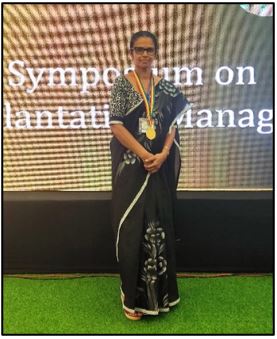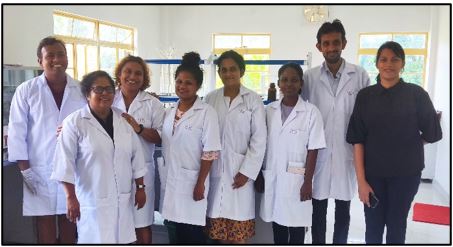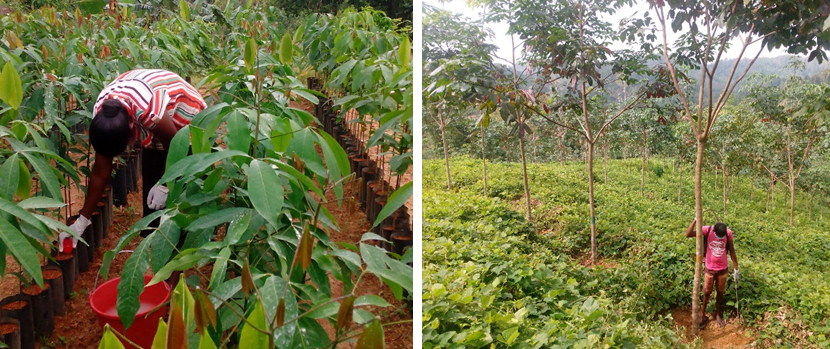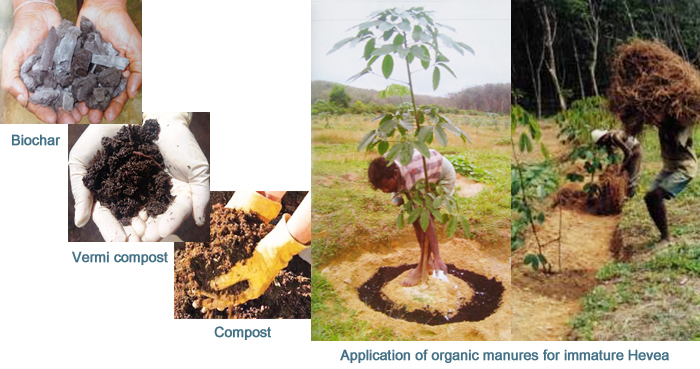පාංශු හා ශාක පෝෂ්යත්ව දෙපාර්තමේන්තුව
The major function of the department is to plan, promote, implement and monitor all research and development activities in relation to improvement of soil fertility, increasing efficiency of nutrient uptake, economizing on fertilizer use, soil, water and nutrient management, and weed management. Effective transfer of research findings and provide technical, advisory and consultancy service to the rubber industry are also leading functions of this department. Site-specific fertilizer recommendation, land selection for planting rubber, and analysis of soil, plant and fertilizer samples are the main services provide by this department. Planning and implementing human resource training in line with the needs of the department and acting as the resource and information centre for the soils and plant nutrition of rubber are also objectives of this department.

Research Officer / Soils Chemist
Mr. L.A.T.S. Liyanaarachchi, BSc (SL), Mphil (Reading) – WUSL
sangeethliyanaarachchi@gmail.com
He is Research Officer in Soil Science, with the expertise on Geographic Information Systems (GIS) related to the soil science and land suitability analysis of crop expansion. Further, he is conducting research on climate change, drought mapping Sri Lanka. His current research activities are focused to Soil Nutrient Mapping and Digital Reflectance Spectroscopy applications for rapid nutrient estimation.
- Introduction of eco-friendly, economically viable biofilm bio-fertilizers which were formulated by using rubber rhizosphere microbes for the enhancement of soil fertility in rubber lands and promote plant growth of nursery plants and immature Hevea.
- Application of slow release fertilizers for rubber nursery plants was observed more benefits compared to conventional fertilizer application. Prevention of environmental pollution, reduced labour costs associated with repeated applications are some of the advantages associated with slow release fertilizers over the conventional applications.
- Encapsulated fertilizers based on rubber latex and coir dust was observed their effectiveness over an extended period under laboratory conditions and are being evaluated at field conditions for immature rubber plants. This technique may help to reduce labour cost and chemical wastage.
- Degraded soil fertility in rubber lands could be improved by proper environmental friendly activities; mulching, cover management, biofertilization, drains, stone terraces and was observed enhancement of some soil properties facilitating to improve soil fertility.
- Application biochar, a novel technology to improve soil fertility was introduced to RPC rubber nurseries and a low cost stove was developed to produce biochar while generating cooking energy.
- Bacterial spp. that can absorb more moisture have been identified and are being used for the development of bio-fertilizers in order to tolerate moisture stress conditions in non-traditional rubber growing areas.
- Mother nurseries of Mucuna cover crop were established and planting materials were issued for smallholder and estate sector to conserve soil and enhancement of soil fertility.
- The land with white root disease history is not advisable to establish Mucuna as a cover crop. In areas identified and demarcated for white root disease patches, RRISL recommended to grow Pueraria, Desmodium or other cover crop
- Rubber growers are provided with a site- specific fertilizer recommendation through the foliar Survey.
- Land suitability reports are issued after selecting suitable lands for rubber cultivation in traditional and nontraditional rubber growing areas.
- Fertilizer samples received from the stakeholders are tested for their quality to assure the application of good quality fertilizers to their rubber lands.
Manuring schedule for mature rubber
| Region | Fertilizer | Quantity (g/tree/year) | |
|---|---|---|---|
| While tapped on virgin bark | While tapped on renewed bark | ||
| Kegalle Kurunegala Kandy | Urea | 200 | 150 |
| ERP | 100 | - | |
| MOP | 100 | 75 | |
| All other rubber growing areas | Urea | 200 | 150 |
| ERP | 100 | - | |
| MOP | 200 | 150 | |
ERP - Eppawala Rock Phosphate MOP - Muriate of Potash
Plantations under the regional plantation companies are strongly advised to obtain site-specific fertilizer recommendation from the RRISL for their mature fields. In areas where fertilizers are not recommended on the basis of foliar survey, fertilizer quantities in the table could be used.
Dr. R.P. Hettiarachchi – Head of the Soils and Plant Nutrition Department, RRISL won the best presenter award for her article entitled “Effect of Slow-Release Fertilizer Techniques on Growth and Mineral Composition of Immature Hevea and Fertility of Rubber Growing Soils” at the National Institute of Plantation Management (NIPM) Symposium in August 2023.






-
Conducting research on establishment of site-specific management zones under traditional rubber plantations for variable rate fertilizer (VRF) application via geo-spatial and geo-statistical approaches.
-
Conducting research on identification of the effect of the nutrient management of rubber growing soils to manage the Circular Leaf Spot Disease (CLSD) with the collaboration of Plant Pathology and Microbiology Department.
-
Conducting efficacy testing for high-efficient fertilizers for nursery and immature rubber at both traditional and non-traditional rubber growing areas.
-
Conducting Private Public Partnership (PPP) research works under the NRC 2023-22 research grant of National Research Council on Rubber Processing Solid waste (Sludge) – Investigation on feasibility as a raw material for the preparation of compost
-
Conducting research on establishment of site-specific management zones under traditional rubber plantations for variable rate fertilizer (VRF) application via geo-spatial and geo-statistical approaches.
- Fertilizer encapsulated coir bricks for immature rubber
The technique of encapsulation of fertilizers as a coir based product is an effective and economical method for overcoming some management problems associated with fertilizer applications. Totally cut down labour charges associated with repeated fertilizer applications, reduction of fertilizer cost by 20%, prevention of environmental hazards and wastage due to extreme leaching loss of nutrients, prevention of possible pilferage and adulteration of fertilizers are some of the benefits associated with fertilizer encapsulated coir bricks.

Application of coir bricks for immature rubber plants
- Commercially available slow release fertilizer for rubber nursery plants
Single application of commercially available slow release fertilizer at bag filling stage showed better growth parameters than conventional biweekly fertilizer applications and could be benefitted for the growers by totally cut down labour cost associated with regular fertilizer applications.

Enhancement of the growth performances of rubber nursery plants by the application of commercially available slow release fertilizer
- Environmental friendly economically viable biofertilizer for rubber nurseries and immature rubber
In the recent developments of biofertilizer research, biofilms have been produced from fungi and bacteria associated with rubber rhizosphere under laboratory conditions and termed as biofilm biofertilizers (BFBF). Considerable attention has been focused recently on BFBF in agriculture is considered to be an eco-friendly product which is more cost effective than chemical fertilizers. Several studies conducted so far with the BFBF under nursery and immature Hevea have revealed that combined use of BFBF with modified fertilizer levels could enhance plant growth, perhaps up to their optimum levels with improved nutrient availabilities and enhanced soil fertility parameters. Further, this clearly contributes to reverse land degradation with rubber cultivation, a generic issue that has been lasted for decades.



Application of biofilm biofertilizer for nursery plants and immature Hevea
- Evaluate the effectiveness of environmental friendly alternatives for inorganic fertilizers
Application of commercially available compost, vermi compost, vermi wash, partially burn paddy husk, paddy straw, green manures reported beneficial effects on nursery plants and immature Hevea performances.

- Rehabilitation of degraded rubber lands by using environmental friendly agro management practices
Combine use of agro management practices such as cover cropping, green manuring, straw mulching and biofertilization showed significant enhancement of soil fertility parameters such as organic carbon, total N, ammonium, available P, exchangeable K and Mg, microbial biomass carbon and growth parameters of immature Hevea..

- Introduction of new fertilizer mixtures for nontraditional rubber growing areas
Different fertilizer mixtures are being evaluated in four different places; Moneragala, Vauniya, Padiyathalawa and Badalkumbura to identify the best fertilizer mixture for non- traditional rubber growing areas.
- Introduction of fertilizer tubes for enhancing fertilizer use efficiency in rubber plantations
Investigate the effectiveness of “fertilizer tube” to enhance fertilizer use efficiency, reduce leaching loss of nutrients and totally cut down fertilizer application cost associated with repeated fertilizer applications for immature Hevea.
- Modification of fertilizer recommendations of Hevea with reference to plant, soil and field parameters
Prepared three soil maps relevant to rubber growing areas in Galle, Matara and Kegalle districts and identified fifteen different soil series based on available sources “Soils of the Wet Zone of Sri Lanka” edited by R B Mapa et al., 1999, etc.Site Specific fertilizer r
Site Specific Fertilizer Recommendation Programme for mature rubber.
The use of fertilizers in the cultivation of rubber is an accepted practice. But optimum growth and yield of plants can be achieved only by properly balancing the nutrients according to the requirements of the rubber tree. Therefore, the foliar surveys of estates provides fertilizer recommendations specially suited to local soil conditions.
Rate : Rs 130.00/ ha
Land Suitability Evaluation Programme
The selection of suitable land with proper soil characteristics is considered as key factor to ensure high return on investment. Therefore, broad range of land and soil properties could be considered for the preparation of land suitability report including of their suitability / unsuitability with appropriate corrective measures.
Rates : Rs. 1200.00/ha
Analytical service
Provide analytical reports on soil, plant, water and fertilizer samples. Specially issues fertilizer analytical reports to assure the application of good quality fertilizers for their rubber lands.
REVISED TESTING CHARGES – July 2022
Testing charges have been revised with effect from 01.07.2022, as mentioned in the following table.
Note: Please note that Transport charges, Priority charges & Institutional charges have not been added to the toal charges. It should be added to the total charges whenever necessary. Figuers are in LKR.
|
Name of the Test
|
Testing Fee (Rs.) |
|
|
1 |
Site Specific Fertilizer Recommendation |
300 |
|
|
Fertilizer/Leaf/ Compost (Total digestions) |
|
|
2 |
N, P, K, Mg |
2800 |
|
3 |
N |
2800 |
|
4 |
P |
2800 |
|
5 |
K |
2800 |
|
6 |
Mg |
2800 |
|
7 |
Ca |
2800 |
|
8 |
Soil N |
2600 |
|
9 |
Soil P |
2600 |
|
10 |
Soil K |
2600 |
|
11 |
Soil Mg |
1900 |
|
12 |
Soil Ca |
1900 |
|
13 |
Soil micronutrient or other |
1900 |
|
14 |
pH |
100 |
|
15 |
Organic Carbon |
600 |
|
16 |
Moisture content |
200 |
|
17 |
Particle size |
200 |
|
18 |
CEC |
2200 |
|
19 |
Soil Texture |
1200 |
|
20 |
Gravel |
200 |
- Hettiarachchi R.P., Chandrasiri, JAS, De Silva, KE, Edirimanna, VU, Thewarapperuma, A, Gunathilake, T, Malawarachchi, GC, Kulathunge, KMMEK, Gayan, MWH and Siriwardana, NS. (2019). Effectiveness of coir dust and rubber latex based slow release fertilizer on the growth of immature rubber (Hevea) and soil nutrient availability. Journal of Rubber Research Institute of Sri Lanka, 99: 66-75.
- Hettiarachchi, R.P., Edirimanna, V., Gunathilake, T., De Silva, E and Chandrasiri, J.A.S. (2022). Role of slow-release fertilizer for immature rubber (Hevea brasiliensis). Bulletin of the Rubber Research Institute of Sri Lanka 59, 44-51.
- Hettiarachchi, R.P., Chandrasiri, J.A.S., De Silva, E., Edirimanna, V., Gunathilake, T., Thewarapperuma, A., Malawaraarachchi, GC., Kulathunge, KMMEK., Rangana, BMK (2023). Effect of slow release fertilizer techniques on growth and mineral composition of immature Hevea and soil fertility on rubber growing soils. Proceedings of the International Symposium on “Sustainable Plantation Management” (NSSPM), National Institute of Plantation Mnagement.4th July 2023. pp157-168.
- Hettiarachchi R.P., Edirimanna V, Gunathilake T, Kulathunge K M M E K, Gayan MWH, , Malawaraarachchi GC, Baddevidana, RM and Rathnasooriya, PDSDO (2019) Slow release fertilizers to enhance soil nutrient levels and plant growth of immature rubber (Hevea brasiliensis). In RS Dharmakeerthi, UWA Vitharana and WS Dandeniy (ed.) Proceedings of the International Symposium on sustainable Soil Management (ISSSM) Soil: Underpinning Life and Environment. Soil Science Society of Sri Lanka. 5-6 December 2019.pp 4-7.
- Hettiarachcchi, R P, Dharmakeerthi, R S, Seneviratne G (2010) Isolation and in – vitro screening of soil born fungi and bacteria of Hevea brasiliensis root rhizosphere for efficient biofilm formation. In Proceedings of
- Hettiarachchi1 R P. *, Edirimanna1 V, Thewarapperuma1 A., Gunathilake1 T., de Silva1 E, Chandrasiri1 JAS, Malawaraarachchi G C 1(2017) Possibility of using sub soil with organic materials as a substitute for top soil and their effect on growth and mineral composition of Hevea seedlings. Journal of Rubber Research Institute of Sri Lanka. Journal of Rubber Research Institute of Sri Lanka (In press).
- Hettiarachcchi, R P, Dharmakeerthi, R S, Seneviratne G, Jayakody A N, De Silva E, Gunathilaka, T. and Thewarapperuma, A (2015) Determination of Desirable Properties of Bacteria, Fungi and Their Biofilm Associated with Rubber Rhizosphere. Tropical Agricultural Rresearch, 26(4): 399-413
- Hettiarachchi R P, Dharmakeerthi R S, Seneviratne G, Jayakody A N, DeSilva E1, Gunathilake1 T, Thewarapperuma1 A and Maheepala C K (2014) Availability and leaching of nutrient after biofilm biofertilizer applications into a Red Yellow Podsolic soil. Journal of Rubber Research Institute of Sri Lanka. Vol.94. 43-53
- Hettiarachcchi, R P, Dharmakeerthi, R S, Seneviratne G, Jayakody A N, De Silva E, Gunathilaka, T. and Thewarapperuma, A (2014) Evaluate the Effectiveness of Fungal Bacterial Interactions as Biofilmed Biofertilizers on Root Growth Enhancement of Hevea Seedlings. Journal of Environmental Professional Sri Lanka. Vol. 3(ii) 25-40.
- Dharmakeerthi RS, Chandrasiri JAS and Edirimanna VU (2013). Humic acid based liquid organic fertilizer improved the growth of nursery and immature rubber plants in Boralu soil series. Journal of Rubber Research Institute of Sri Lanka. (93) 1-15.
- Hettiarachchi RP, Dharmakeerthi RS, Seneviratne G, Jayakody AN, Edirimanna V (2012) Effect of biofilm bio fertilizers on growth and mineral composition of Hevea seedlings under green house conditions, pp, 195 – 203. In LSK Hettiarachchi and ISB Abeysinghe (ed.) Proceedings of the 4th Symposium on Plantation Crop Research - Technological Innovations for Sustainable Plantation Economy. Tea Research Institute of Sri Lanka, St. Coombs, Talawakelle, 22100, Sri Lanka.195-204.
- Gunathilaka,D.N.M,Yapa, P.N,.Hettiarachchi R.P and Thewarapperuma A.P. (2017) Assessing the effect of arbuscular mycorrhizal fungi on the phytoremediation potential of Eichhornia crassipes (Mart.) Solms on cadmium uptake. Ground water for sustainable development, ELSEVIER (Under review)
- Dharmakeerthi RS, Chandrasiri JAS and Edirimanna VU (2012). Effect of rubberwood biochar on nutrition and growth of nursery plants of Hevea brasiliensis established in an Ultisol. SpringerPlus 1-84.
- Dharmakeerthi RS, Chandrasiri JAS and Edirimanna VU (2013). Rubberwood biochar; Production and some agronomic benefits when used in rubber nurseries. Journal of national Institute of plantation management 27(1): 32-39.
- Dharmakeerthi RS, Perera SP, Edirimanna VU and Chandrasiri JAS (2011) Changes in fertility of a degraded Ultisols in Sri Lanka after amending with rubberwood biochar. Proceeding of the 10th International Conference of the East and Southeast Asia Federation of Soil Science Societies. Oct 10-13, Colombo, Sri Lanka.. Soil Soil Science Society of Sri Lanka, Peradeniya, Sri Lanka. 195-196.
- Hettiarachchi R P, Dharmakeerthi RS and Seneviratne G (2011) Biofilm: A new group of biofertilizer for Rubber plantation. Bulletin of Rubber Research Institute of Sri Lanka. 18-22.
- Dharmakeerthi RS, Chandrasiri JAS and Edirimanna VU (2010) Use of charcoal as a soil amendment in Rubber (Hevea brasiliensis) plantations: Effectiveness in young budding polybagged plants. In Proceedings of the third Symposium on Plantation Crop Research. – “Stakeholder Empowerment through Technological Advances “- (Eds, RS Dharmakeerthi and AMWK Senevirathna), Rubber Research Institute of Sri Lanka, Dartonfield, Agalawatta. Sri Lanka.p.179-188.
- Dharmakeerthi RS, Siriwardana EAD, Edirimanna VU and Chandrasiri JAS (2009) Growth of young budding plants as affected by type and packing density of the potting. Journal of Rubber Research Institute of Sri Lanka. 89: 46-57.
- Dharmakeerthi RS, Chandrasiri JAS and Edirimanna VU (2008). Agroclimatalogical potential of the Hambanthota district for rubber cultivation. Bulletin of the Rubber Research Institute of Sri Lanka. 49: 17-22.
- Dharmakeerthi RS, Seneviratna AMWK., Edirimanna VU and Chandrasiri JAS (2008). Effect of stock pruning on shoot and root growth of budded polybag plants of Hevea brasiliensis. Natural Rubber Research 21: 24-31.
- Hettiarachcchi, R P, Dharmakeerthi, R S, Seneviratne G, Jayakody A N, De Silva E, Gunathilaka, T. and Thewarapperuma, A (2015) Biofilmed biofertilizers as key player in improving soil fertility and plant growth of Rubber (Hevea brasiliensis) seedlings. In Proceeding of the twentieth International Forestry and Environmental Symposium. Department of Forestry and Environmental Science, university of Sri Jayawardenepura. pp 85.
- Hettiarachcchi, R P, Dharmakeerthi, R S, Seneviratne G (2010) Isolation and in – vitro screening of soil born fungi and bacteria of Hevea brasiliensis root rhizosphere for efficient biofilm formation. In Proceedings of the third Symposium on Plantation Crop Research. – “Stakeholder Empowerment through Technological Advances “- (Eds, RS Dharmakeerthi and AMWK Senevirathna), Rubber Research Institute of Sri Lanka, Dartonfield, Agalawatta. Sri Lanka.p.328
- Hettiarachcchi, R P, Dharmakeerthi, R S, Seneviratne G, Jayakody A N, De Silva E, Gunathilaka, T. and Thewarapperuma, A (2014) Influence on shoot and root growth of Hevea nursery plants at field conditions by application of biofilmed biofertilizer. In Proceeding of the nineteenth International Forestry and Environmental Symposium. Department of Forestry and Environmental Science, university of Sri Jayawardenepura.125pp
- Hettiarachcchi, R P, Dharmakeerthi, R S, Seneviratne G, Jayakody A N, De Silva E, Gunathilaka, T. and Thewarapperuma, A (2013) Phosphate Solubilizing bacteria and fungi isolated from rubber (Hevea brasiliensis) root rhizosphere, their biofilm formation and phosphate solubilizing abilities. In proceeding of the eighteenth International Forestry and Environmental Symposium. Department of Forestry and environmental Science, university of Sri Jayawardenepura.p.89
- Liyanaarachchi, L.A.T.S., Sankalpa, J.K.S., Ishani, P.G.N., Rathnayaka, A.M.R.W.S.D., Gayan, M.W.H., Wijesuriya, B.W. and Hetiarachchi, R.P., 2022. Annual soil loss assessment of smallholder rubber growing lands in the Kalutara District, Sri Lanka using the RUSLE model in GIS. Journal of the Rubber Research Institute of Sri Lanka, 102, pp.43-54.
- Liyanaarachchi, L.A.T.S., Wijesuriya, B.W., Sankalpa, J.K.S., and Gayan, M.W.H. (2021). Identification of Land Suitability For Expanding Rubber Cultivation: A GIS Based Case Study in Embilipitiya and Kolonne areas in Ratnapura District. Bulletin of Rubber Research Institute of Sri Lanka, Vol. 57, 2020. 1-11..
- Gunathilaka D.N.M.,.Hettiarachchi R.P and.Yapa P.N (2017), Effect of different cadmium concentrations on growth and phytoremediation potential of Eichhornia crassipes (Mart.) Solms (water hyacinth): pp.20, In proceedings of Peradeniya University International Research Sessions (iPURSE 2017 – 24th November), University of Peradeniya, Peradeniya, Sri Lanka.
- Gunathilaka, D.N.M Yapa, P.N..Hettiarachchi R.P and.Thewarapperuma A.P (2017), Assessing the effect of arbuscular mycorrhizal fungi on the phytoremediation potential of Eichhornia crassipes (Mart.) Solms on cadmium uptake: pp 34-35, In International Symposium on Sustainable Urban Environment (ISSUE 2017-23rd – 24th June, 2017), Tezpur University, Assam, India.
- Gunathilaka, D.N.M Yapa P.N. and.Hettiarachchi R.P (2017), Arbuscular mycorrhizal fungi for increasing the phytoremediation potential of plants in heavy metal contaminated sites: In proceedings of Second Global Soil Biodiversity Conference (GSBS 2-15th-19th October, 2017), Nanjing.
- Gunathilaka, D.N.M Yapa P.N. and.Hettiarachchi R.P (2017), Assessing the effect of arbuscular mycorrhizal fungi on the phytoremediation potential of Eichhornia crassipes (Mart.) Solms (water hyacinth) on cadmium uptake: pp 4, In proceedings of Applied Sciences Undergraduate Research Sessions 2017 (ASUR 2017 – 4th October, 2017) Rajarata University of Sri Lanka, Mihinthale, Sri lanka.






 Call 1919
Call 1919